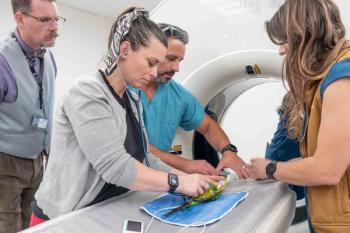
Computed tomography (Proceedings)
The use of computed tomography (CT), though not readily available at every institution, is becoming a more widespread modality for use in the small animal patient. Computed tomography affords a rapid evaluation of skeletal images with a small slice thickness that can be as small as 0.625.
The use of computed tomography (CT), though not readily available at every institution, is becoming a more widespread modality for use in the small animal patient. Computed tomography affords a rapid evaluation of skeletal images with a small slice thickness that can be as small as 0.625. Computed tomography in chondrodystrophic breeds of dogs is being performed instead of myelography due to the rapid acquisition and ability to see mineralized disc material. Due to the increased availability of multislice CT scanners, sedated CT scans are becoming possible due to the fast acquisition time. The purpose of this proceeding is to describe the physics and benefits of CT imaging in the small patient and the new uses that this modality provides.
Computed tomography is a method of image acquisition similar to radiography. An x-ray tube is used to generate photons that pass through a patient and is read by a detector (similar to digital radiography). Where CT differs is the fact that the x-ray tube spins around the object being imaged to provide a cross-section of each section of the object without superimposition of structures as occurs with conventional radiographs. This elimination of superimposition allows for enhanced ability to detect fracture fragments, improves the ability to localize lesions (such as dental disease and sinus lesions) and increases the ability to see smaller lesions, when compared to conventional radiography.
Computed tomographic technology is generally talked about in terms of what "generation" a scanner is considered. For example, a third generation scanner (also called a rotate-rotate scanner) has a series of detectors that spins with the x-ray tube. A fourth generation scanner (also called a rotate-stationary scanner) has a spinning x-ray tube and a complete ring of transducers that do not move with the x-ray tube. A sixth generation scanner is the most widely available today and this is also called a helical scanner. The difference is that a fourth generation scanner generally has a large number of detectors, which means better resolution, when compared to the third generation scanner. A helical scanner allows for continuous acquisition of an image while the table moves to decrease the scan time required.
The way an image is generated in a normal acquisition is that the x-ray tube completely circles the desired area and an image is generated. This provides the best possible resolution, but when three-dimensional reconstruction is performed, the image can look very irregular. This is because, like slices of bread, each slice will not perfectly align with the image cranial and caudal making a stepped appearance. During a helical acquisition, the table continues to move through the gantry allowing only 66% of a complete revolution around the object. The remaining 34% of the image is then extrapolated from the slice in front of the image and behind the image. Though this means that the image is not completely accurate, but it provides for a smoother transition between slices, smaller slice thickness and a more rapid acquisition.
Due to the use of x-ray technology, the use and interpretation of CT is more intuitive then other modalities like ultrasound or magnetic resonance imaging. Computed tomography works on the basis of attenuation of the x-ray beam. Due to this difference in attenuation, it is possible to see acute hemorrhage, mineralization, small fragments of bone secondary to a fragmented medial coronoid process, as well as the difference between fluid and soft tissue when contrast medium is given.
Computed tomography's main benefits are rapid acquisition and lack of superimposition. The average CT study can take approximately 2-3 minutes per acquisition. Multislice CT scanners are similar to single slice, except that the multislice scanners have multiple rows of detectors allowing more than one slice to be acquired at a time. Multislice scanners range from 2 slice to 256, or infinite, slice. The more detectors that are present, the faster the acquisition and the smaller the possible slice thickness. However, just like with radiographs, a small slice thickness means more energy is required, which would adversely increase the patient's radiation dose. A complete head CT of a dog using a multislice CT scanner generally will take 20 seconds.
Due to the rapid acquisition and the amount of image detail, CT is considered the first imaging modality to evaluate the nasal cavity, the elbows and the thorax for pulmonary metastatic disease. Computed tomography is also ideal for trauma patients or patients that are paralyzed and are not stable enough for longer procedures like MRI. With the ability to reconstruct images in multiple planes as well as generating three-dimensional images, CT can provide rapid guidance for surgeons as well as being used by oncology for radiation therapy planning.
The most common use for CT is evaluation of the head and cranial vault. Though CT does not have the soft tissue detail as seen with MRI, CT with administration of contrast medium, has the ability to see morphologic lesions of the brain that would require radiation therapy or surgical removal. Computed tomography is also superior to evaluate the bone structures of the head including the tympanic bulla and temporomandibular joints. When precise evaluation of fractures is needed, CT can provide a large amount of detail into the amount of fragmentation as well as fracture lines that are present in the bone, which may not be visible using conventional radiography.
Computed tomography is also useful in evaluating the vertebral canal for lumbosacral disease, intervertebral disc herniation and spinal tumors. If a myelogram has been performed, CT is able to provide more information about the spinal cord even hours after the contrast medium has been administered. Since fluid and soft tissue have the same attenuation, the spinal cord silhouette is seen comprising the spinal cord and subarachnoid space. However, when contrast medium is given intrathecally, then compressive lesions of the spinal cord can be properly assessed. Subtle lytic lesions seen with discospondylitis can also be seen on CT before they are visible with radiography.
In the thorax, CT has become the gold standard for pulmonary metastatic disease. This is because CT provides higher contrast resolution, which is the ability to see two objects of different opacities as different, compared to radiographs. Therefore, small soft tissue nodules are easily seen in the lungs due to the lack of superimposition. In addition, mediastinal masses and rib tumors can be easily identified and assessed using CT due to the lack of superimposition seen with radiographs.
The newest technique that is gaining more favor is CT angiography. Using timed boluses of contrast medium allows for the vasculature to be critically evaluated. Combine this with the rapid acquisition and CT is becoming the modality of choice for portosystemic shunt evaluations. Also, arterial verse venous phases can be evaluated for masses in the liver and pancreas and show promise in helping to determine neoplastic masses from hypertrophy. However, more research is needed before definitive assessments can be made. Computed tomographic angiography is also helpful for adrenal gland masses to assess for involvement of the surrounding vasculature. Due to the large size of the masses and the central location of the caudal vena cava, accurate evaluation of vessel involvement is sometimes not possible. Using CT and contrast medium, filling defects can be seen in the vasculature to indicate a thrombus or extension of the mass into the vascular structure or even provide information about how vascular a mass is prior to surgical removal.
Computed tomography is faster and provides better bone detail than any other modality currently in use. The ability to produce sub-millimeter slice thickness that can be rapidly reconstructed into any image plane prior to performing surgery makes this the modality of choice when time is of the essence. Patients with metal implants can be imaged using CT and since ultrasound cannot penetrate gas, abdominal CT is becoming recommended instead of ultrasound especially to evaluate the abdomen in large breed dogs.
Computed tomography is more readily available due to the decreased cost of purchasing and maintaining the machine compared to magnetic resonance imaging. With newer CTs being made, multislice CT scanners (4-16 slice) are being used in veterinary medicine on a routine basis. The speed of acquisition, the possibility of using sedation rather than general anesthesia and the lack of superimposition makes CT the modality of choice for nasal imaging or lesions that are suspected to have bone involvement. Though MRI is still superior to look at soft tissue lesions or for neurologic localization, CT remains the first modality to provide rapid assessment and determination of acute surgical lesions compared to other modalities.
Newsletter
From exam room tips to practice management insights, get trusted veterinary news delivered straight to your inbox—subscribe to dvm360.






